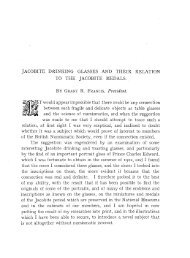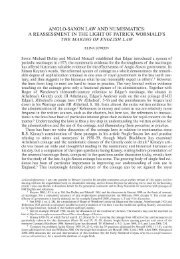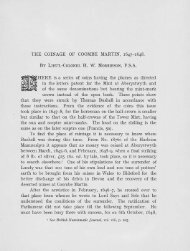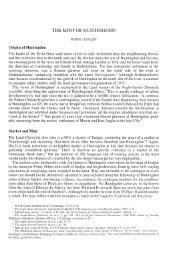MONEYERS IN THE 1130 PIPE ROLL
MONEYERS IN THE 1130 PIPE ROLL
MONEYERS IN THE 1130 PIPE ROLL
You also want an ePaper? Increase the reach of your titles
YUMPU automatically turns print PDFs into web optimized ePapers that Google loves.
2 <strong>MONEYERS</strong> <strong>IN</strong> <strong>THE</strong> <strong>1130</strong> <strong>PIPE</strong> <strong>ROLL</strong><br />
introduction of a new type all citizens were required to take their old pennies to the nearest<br />
mint and exchange them for new ones. Others have suggested the recoinage was the<br />
practical consequence of a provision that certain official payments such as taxes should<br />
only be made in the current type of coin, or that sheriffs had to account to the exchequer<br />
for the returns from their counties in coin produced by their own moneyers. But, whatever<br />
the mechanism, the type XV system would have constituted a radical financial upheaval<br />
(although seemingly one put into reverse soon after Henry's death, when most of the<br />
smaller mints were revived). There would certainly have been consequences for royal<br />
revenue, perhaps in respect of taxation itself, but even if not, through loss of farms, fees or<br />
seignorage, for which the crown could be expected to have sought some compensating<br />
remedy. Whatever the reason had been during the previous hundred and fifty years for<br />
having a comprehensive network of mints, county by county, it can no longer have applied<br />
during the currency of type XV, or at least not in the same way. The reduction in the<br />
number of mints and moneyers after type XIV therefore goes far beyond the necessary<br />
process of replacing dishonest moneyers with new ones, but why such far-reaching changes<br />
were introduced remains unexplained. It is, however, against that background that we<br />
need to consider the occurrence of the names of moneyers in the Pipe Roll.<br />
Moneyers had figured in English official documents since the time of Offa, and there are<br />
many instances in the Saxon period to suggest that they were persons of rank and<br />
importance in public affairs. 7 When the exchequer and other records become plentiful,<br />
from the second half of the twelfth century, there are frequent references to men described<br />
as moneyers, and it is likely that others named include persons who at one time or another<br />
were responsible for coinage. Most of the names of moneyers in the Pipe Rolls of Henry II<br />
find mention there at approximately the dates when they were signing coins, but there are<br />
entries which imply that the moneyer concerned was not currently exercising the office,<br />
many of the entries repeated from year to year being of this kind. More than twenty of the<br />
names recorded under Henry II can be identified as moneyers of Stephen, mostly not<br />
continuing after 1158, and many of these entries must therefore fall some years after the<br />
persons concerned had ceased to be named on the coinage. 8 One should not be surprised to<br />
find the same thing happening under Henry I. Fines or other debts were often carried<br />
forward from year to year, as is evident from the repeated entries in the period where the<br />
rolls survive continuously. In the case of the <strong>1130</strong> Pipe Roll, because it stands alone, this<br />
unfortunately means that we do not know when such debts were first incurred, or how<br />
much of the original debt had by then been discharged.<br />
A further problem in relation to the reign of Henry I is that our record of mints and<br />
moneyers is so incomplete. Because of such large hoards as Bournemouth, Lincoln,<br />
'Beauvais' and Watford, from the later years of Henry I's reign or the beginning of<br />
Stephen's, we must know the great majority of mints and moneyers' names in types XIV<br />
and XV, but even in these two types the 'Beauvais' hoard contained surprises, adding the<br />
mints of Pembroke and Sudbury in type XV, the latter particularly unexpected as making<br />
Suffolk the only county in the kingdom to have had three mints active during the type. Of<br />
the first thirteen types of the reign it is clear that we know only a selection of the mints and<br />
moneyers, and new hoards can be relied upon to increase their number substantially. Thus<br />
the Lincoln hoard added no fewer than fifteen new moneyer/type combinations for the<br />
Lincoln mint from types VII to XV. Any discussion of the careers of individual moneyers<br />
can therefore only be of a most provisional kind, and is liable to major revision in the light<br />
of subsequent discoveries. The table appended hereunder of the types recorded for the<br />
7 I. Stewart, 'Ministri and Monetarii', RN 30 (1988), Elmore Jones, 'Stephen Type VII', BNJ 28 (1955-7), 537-54<br />
166-75. (see p. 547).<br />
8 D.F. Allen, BMC Henry II, pp. lxv-lxxi and cv-cvi; F.



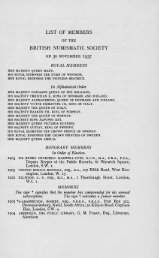

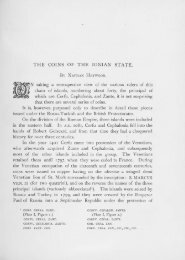
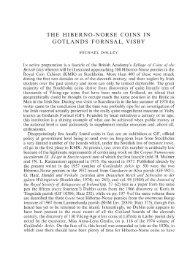
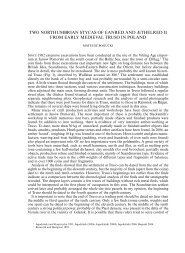

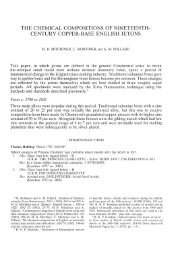
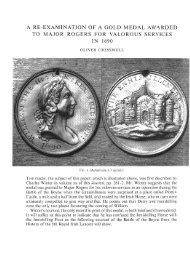
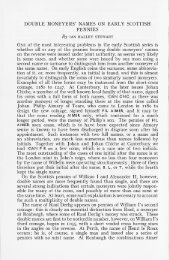
![Two Anglo-Saxon notes: [1] A Cnut die-link between the mints of ...](https://img.yumpu.com/15433998/1/189x260/two-anglo-saxon-notes-1-a-cnut-die-link-between-the-mints-of-.jpg?quality=85)
